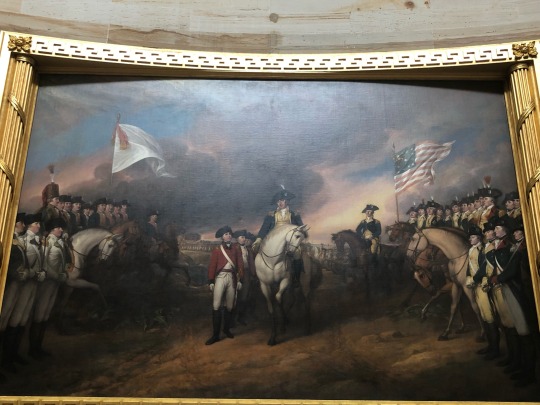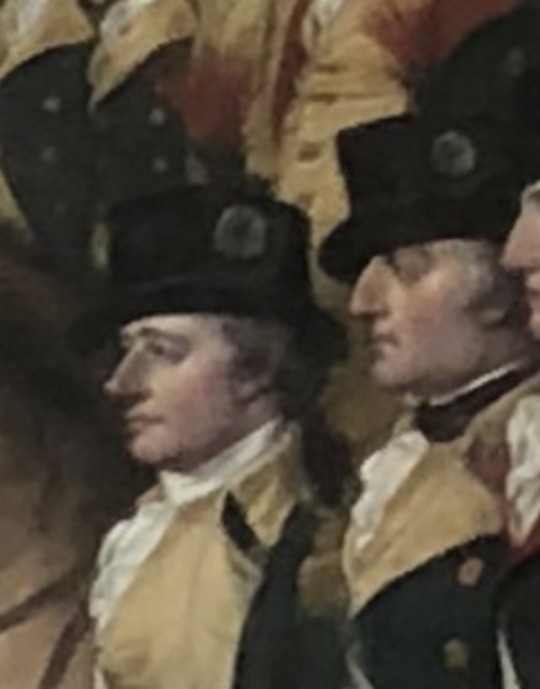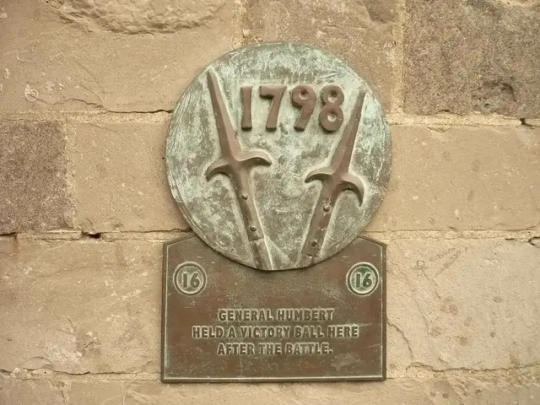#Lord Cornwallis
Text
My first full-length history book is out today!

The Pattern: The 33rd Regiment and the British Infantry Experience During the American Revolution, 1770 - 1783, follows the 33rd Regiment, arguably one of the best in the British Army, through its campaigns during the American Revolutionary War.
The book aims to give a complete understanding of the 33rd and their experiences, so it’s not just a regimental history. Opening chapters deal with recruitment, training, weapons, clothing and equipment, as well as the home service 1770-75, where the regiment acquired a reputation for excellence.
There’s also statistical analysis! I look at where the 33rd’s soldiers came from, what jobs they did before enlisting, their age, their height, and how long they served for.
After that there’s a chapter dealing with the events of each year from 1776 to 1783. Not just combat either, though there’s loads of that - diet, disease, discipline and desertion, the role of women, camp life and the experiences of transatlantic voyages are among the topics dealt with.
It’s also got;
Over 100,000 words of core text
40 images
Over a dozen BATTLEMAPS
Specially commissioned artwork
Graphs and tables
An appendix!
Purchase links below. This has been a two-year labour of love, so all the support, be it buying a copy or just reblogging this, is much appreciated:
Helion
Barnes & Noble
Waterstones
Amazon US
Amazon UK
#history#military history#american revolution#revwar#american war of independence#18th century#british army#33rd foot#lord cornwallis#cornwallis
385 notes
·
View notes
Text
#OTD in 1801 – The trial of United Irishman, Napper Tandy, begins.
James Napper Tandy was born in the Cornmarket area of Dublin in 1740; one of three children born to James Tandy, an iron works merchant, and Maria Bella Jenkins. Tandy received his education at the Quaker boarding school in Ballitore, Kildare, amongst its alumni Edmund Burke, a champion of Catholic emancipation and a supporter of American independence.
Originally a small tradesman in Dublin, he…

View On WordPress
#1798 United Irishmen Rebellion#Bordeaux#Donegal#Dublin#England#exile#France#French#History of Ireland#Irish History#James Napper Tandy#Lord Cornwallis#The Wolfe Tones#Wearing Of The Green
7 notes
·
View notes
Text

December 31, 1781
Henry Laurens was traded for Lord Cornwallis after 15 months of imprisonment in the Tower of London.
16 notes
·
View notes
Text
Administrative, Judiciary and Reforms of Lord Cornwallis :-
Major Reforms of Lord Cornwallis :-
1). He eliminated many jobs that were held only to please the executives or members of the control board.
2). He forced the management of the company to increase the wages of the workers.
3). The personal business of the employees of the company was banned.
4). It was during his reign that rules were made that no Indian could be given a post higher than Droga or Munshi and his salary could not exceed 500 pounds. This was a great blunder by Cornwallis and a stain on his name.

2). Judicial Reforms
1). Following Civil Courts :- Cornwallis established a series of civil courts. At the lowest level were the Munsif's courts, headed by Indian officials. They could hear cases up to Rs.50. Above these were the registrar's courts, which were under European judges. They had the right to hear cases up to Rs.200. Above these were the district courts. District Courts were under District Judges. These courts heard appeals against lower courts.
2). Provincial Courts :- Four Provincial Courts were established to hear appeals against the District Courts. They were established in Calcutta, Dhaka, Patna and Murshidabad. The judges of these courts were Englishmen and they heard appeals against suits up to 100 Rs. Apart from hearing the cases, their main task was also to observe the courts. Read more :-
1 note
·
View note
Text
American Foreign Policy Since 1945
The United States of America, with its founding in 1775 and winning the American Revolution or, more accurately, a British civil war which lasted until 1783 over the 19th 1781 with the surrender of General Lord Charles Cornwallis
The United States of America, with its founding in 1775 and winning the American Revolution or, more accurately, a British civil war which lasted until 1783 over the 19th 1781 with the surrender of General Lord Charles Cornwallis surrendered 7087 officers and 900 seamen hundred and 40 cannons 15 galleys a frigate and 30 transport vessels.
During the day of the surrender, General Cornwallis…

View On WordPress
#America History#American Foreign Policy#American Mexican War#Bill Clinton#Charles CornWallis#Confederate States of America#European History#French Revolutionary War#George H. W. Bush#George Washington#History#Lord Cornwallis#Robert E Lee#Treaty of Paris
1 note
·
View note
Text
Since Bung is deleting their channel, my friend decided to archive all the (important) SCP Confinement videos onto a Google Drive Folder
I'm only uploading this in behalf because they don't want their name associated with Confinement so go nuts. (you can reupload these)
#scp#scp confinement#scp foundation#scp fandom#scp connor#confinement#confinement scp#connor cornwall#scp series#lord bung#scp mythos#hate how this is my first post here
144 notes
·
View notes
Text
La Fayette and the Monarchy – a Summary
La Fayette’s relationship with the Monarchy, both in France and elsewhere in Europe, was often a rather strained one. While he was not opposed to the institution of the monarchy as such, he often found himself at odds with the ruling families. But regardless of the times and the relationship then existing between La Fayette and Europe’s crowned heads – there was almost always also a certain comedic or even ironical element to it.
So here is a little list of some of La Fayette “best moments”:
La Fayette insulted the future Louis XVIII (and angered his father-in-law in the process)
La Fayette on the future William IV (aka the “Royal Little Tar”)
La Fayette trying to apologize to Louis XVI after going against his direct orders not to sail to America
La Fayette at a dinner party with Lord Cornwallis, Frederick, Duke of York and Frederick the Great
La Fayette featured in rather explicit prints with Marie Antoinette
Queen Charlotte’s approval of La Fayette’s imprisonment
La Fayette’s descendant currently sits on the Belgian Throne
… to be continued
#marquis de lafayette#la fayette#french history#american history#american revolution#french revolution#marie antoinette#louis xvi#louis xviii#lord charles cornwallis#frederick duke of york#frederick the great#history#french monarchy#belgium monarchy#british royal family
61 notes
·
View notes
Text
I GOT TO SEE IT
THE PAINTING
IN PERSON

AT THE CAPITOL BUILDING

AND THERE THEY ARE
OUR FAVORITE REVOLUTIONARY HOMOSEXUALS
RIGHT NEXT TO EACH OTHER
#aaahhhhh i’m so fucking excited#i got to take a picture next to it#ahhhhh#i saw a bunch of other things too but this was clearly the most important#surrender of lord cornwallis#historical lams#historical hamilton#hamilton#historical john laurens#amrev#american revolution
148 notes
·
View notes
Text








Full General Sir Henry Clinton in TURИ (Mentions)
Grand Knight Cross of Bath, Commander-in-Chief, He Who History Frowns Upon
TURN and Henry Clinton [ 1 / ? ]
#history#amrev#turn: washington's spies#sir henry clinton#gifs#gifset#my gifs#benedict arnold#lord charles cornwallis#turn amc#american revolution#period drama
4 notes
·
View notes
Text
Lostwithiel is just the prettiest town name ever
#it sounds like something from the lord of the rings#so pretty#man rick stein can talk about cornwall#translation seems never-ending today#of course that might also be because during the time I should have been working I've half written two fics#and now I'm on tumblr
1 note
·
View note
Text
#OTD in 1798 – Wolfe Tone’s United Irish and French forces clash with the British Army in the Battle of Castlebar.
The Battle of Castlebar near the town of Castlebar, Co Mayo. A combined force of 2,000 French troops and Irish patriots routed a force of 6,000 British militia in what would later become known as the “Castlebar Races” or “Races of Castlebar”.
The long-awaited French landing to assist the Irish revolution begun by Theobald Wolfe Tone’s Society of United Irishmen had taken place five days…

View On WordPress
#1798 United Irishmen Rebellion#Castlebar#Co. Mayo#General Jean Joseph Amable Humbert#History of Ireland#Ireland#Irish History#Lord Cornwallis#Lord Lieutenant of Ireland#Republic of Connacht#Theobald Wolf Tone
8 notes
·
View notes
Text
Me trying not to go on a rant about how after the war in America ended General Cornwallis went on to have an illustrious career as admittedly one of the better people in the late 18th century Irish government (but only due to not being Cooke or Carhampton) and how he was instrumental to creating the Union but was then forced to resign over Catholic emancipation (this will inevitably turn into a rant about how I would genuinely kill George iii if I ever got my hands on him) every single time one of my Amrev mutuals mentions him

#same with hoche and my frev mutuals. frev tumblr did you know that lazare hoche dying stopped wolfe tone from getting a fleet to ireland#charles cornwallis#lord carhampton#edward cooke#george iii#1798 rebellion#jory.txt
5 notes
·
View notes
Text
@inadxquacyy liked for a starter
Standing in his riding gear, William cannot help but shake his head with a bright laugh as he watches Laura approach at pace atop his best stud horse.

“Has anyone ever told you, that you ride like a soldier galloping proudly into battle?” He asks rhetorically with another amused chuckle.
“If you are to succeed in attracting a nobleman, you must master the beast effortlessly. Not with such determined passion, but rather passively, as if one were afloat and, if I may add, with your legs slanted over one side and very much together.”
Lighting a small cigar, the Earl wafts the smoke away from his general domain. “Women with their legs so widened…” Gesturing vaguely towards her parted thighs with the end of his cigar, William allows his gaze to linger for a moment longer than is truly proper “…only truly succeed in making men think of them in such a position in their bedchambers, no matter how accomplished they may be in the pasture.”
#inadxquacy#Laura#[William Cavendish] What is exhilarating in bad taste is the aristocratic pleasure of giving offense#Lord William Cavendish - Earl of Cornwall#1840#Closed starter
3 notes
·
View notes
Text
the thing w what is dorne based on is ‘dornish = cornish dorne is cornwall’ and ‘the dornish marcher lords to secure a disputed conquest is exactly what was happening to wales in the medieval period dorne is wales’ both hold water they’re both reasonable observations. however they’re both mainly used to argue dorne is white (i assume to make the targaryens look less shitty for the everything) which it just isn’t its a combination of both of the above turkey and moorish spain. theres several diasporas in dorne (some of which are white) which is its own can of worms but ‘how do we feel about grrm’s treatment of this group with brown skin hooked noses black eyes and spicy food in his 90s fantasy series’ is not a problem best solved by pretending they were always meant to be white
351 notes
·
View notes
Text
Endangered Indian sandalwood. British war to control the forests. Tallying every single tree in the kingdom. European companies claim the ecosystem. Spices and fragrances. Failure of the plantation. Until the twentieth century, the Empire couldn't figure out how to cultivate sandalwood because they didn't understand that the plant is actually a partial root parasite. French perfumes and the creation of "the Sandalwood City".
---
Selling at about $147,000 per metric ton, the aromatic heartwood of Indian sandalwood (S. album) is arguably [among] the most expensive wood in the world. Globally, 90 per cent of the world’s S. album comes from India [...]. And within India, around 70 per cent of S. album comes from the state of Karnataka [...] [and] the erstwhile Kingdom of Mysore. [...] [T]he species came to the brink of extinction. [...] [O]verexploitation led to the sandal tree's critical endangerment in 1974. [...]
---
Francis Buchanan’s 1807 A Journey from Madras through the Countries of Mysore, Canara and Malabar is one of the few European sources to offer insight into pre-colonial forest utilisation in the region. [...] Buchanan records [...] [the] tradition of only harvesting sandalwood once every dozen years may have been an effective local pre-colonial conservation measure. [...] Starting in 1786, Tipu Sultan [ruler of Mysore] stopped trading pepper, sandalwood and cardamom with the British. As a result, trade prospects for the company [East India Company] were looking so bleak that by November 1788, Lord Cornwallis suggested abandoning Tellicherry on the Malabar Coast and reducing Bombay’s status from a presidency to a factory. [...] One way to understand these wars is [...] [that] [t]hey were about economic conquest as much as any other kind of expansion, and sandalwood was one of Mysore’s most prized commodities. In 1799, at the Battle of Srirangapatna, Tipu Sultan was defeated. The kingdom of Mysore became a princely state within British India [...]. [T]he East India Company also immediately started paying the [new rulers] for the right to trade sandalwood.
British control over South Asia’s natural resources was reaching its peak and a sophisticated new imperial forest administration was being developed that sought to solidify state control of the sandalwood trade. In 1864, the extraction and disposal of sandalwood came under the jurisdiction of the Forest Department. [...] Colonial anxiety to maximise profits from sandalwood meant that a government agency was established specifically to oversee the sandalwood trade [...] and so began the government sandalwood depot or koti system. [...]
From the 1860s the [British] government briefly experimented with a survey tallying every sandal tree standing in Mysore [...].
Instead, an intricate system of classification was developed in an effort to maximise profits. By 1898, an 18-tiered sandalwood classification system was instituted, up from a 10-tier system a decade earlier; it seems this led to much confusion and was eventually reduced back to 12 tiers [...].
---
Meanwhile, private European companies also made significant inroads into Mysore territory at this time. By convincing the government to classify forests as ‘wastelands’, and arguing that Europeans would improves these tracts from their ‘semi-savage state’, starting in the 1860s vast areas were taken from local inhabitants and converted into private plantations for the ‘production of cardamom, pepper, coffee and sandalwood’.
---
Yet attempts to cultivate sandalwood on both forest department and privately owned plantations proved to be a dismal failure. There were [...] major problems facing sandalwood supply in the period before the twentieth century besides overexploitation and European monopoly. [...] Before the first quarter of the twentieth century European foresters simply could not figure out how to grow sandalwood trees effectively.
The main reason for this is that sandal is what is now known as a semi-parasite or root parasite; besides a main taproot that absorbs nutrients from the earth, the sandal tree grows parasitical roots (or haustoria) that derive sustenance from neighbouring brush and trees. [...] Dietrich Brandis, the man often regaled as the father of Indian forestry, reported being unaware of the [sole significant English-language scientific paper on sandalwood root parasitism] when he worked at Kew Gardens in London on South Asian ‘forest flora’ in 1872–73. Thus it was not until 1902 that the issue started to receive attention in the scientific community, when C.A. Barber, a government botanist in Madras [...] himself pointed out, 'no one seems to be at all sure whether the sandalwood is or is not a true parasite'.
Well into the early decades of twentieth century, silviculture of sandal proved a complete failure. The problem was the typical monoculture approach of tree farming in which all other species were removed and so the tree could not survive. [...]
The long wait time until maturity of the tree must also be considered. Only sandal heartwood and roots develop fragrance, and trees only begin developing fragrance in significant quantities after about thirty years. Not only did traders, who were typically just sailing through, not have the botanical know-how to replant the tree, but they almost certainly would not be there to see a return on their investments if they did. [...]
---
The main problem facing the sustainable harvest and continued survival of sandalwood in India [...] came from the advent of the sandalwood oil industry at the beginning of the twentieth century. During World War I, vast amounts of sandal were stockpiled in Mysore because perfumeries in France had stopped production and it had become illegal to export to German perfumeries. In 1915, a Government Sandalwood Oil Factory was built in Mysore. In 1917, it began distilling. [...] [S]andalwood production now ramped up immensely. It was at this time that Mysore came to be known as ‘the Sandalwood City’.
---
Text above by: Ezra Rashkow. "Perfumed the axe that laid it low: The endangerment of sandalwood in southern India." Indian Economic and Social History Review 51, no. 1, pages 41-70. March 2014. [Bold emphasis and some paragraph breaks/contractions added by me. Italicized first paragraph/heading in this post added by me. Presented here for commentary, teaching, criticism purposes.]
#a lot more in full article specifically about#postindependence indian nationstates industrial extraction continues trend established by british imperial forestry management#and ALSO good stuff looking at infamous local extinctions of other endemic species of sandalwood in south pacific#that compares and contrasts why sandalwood survived in india while going extinct in south pacific almost immediately after european conques#abolition#ecology#imperial#colonial
205 notes
·
View notes